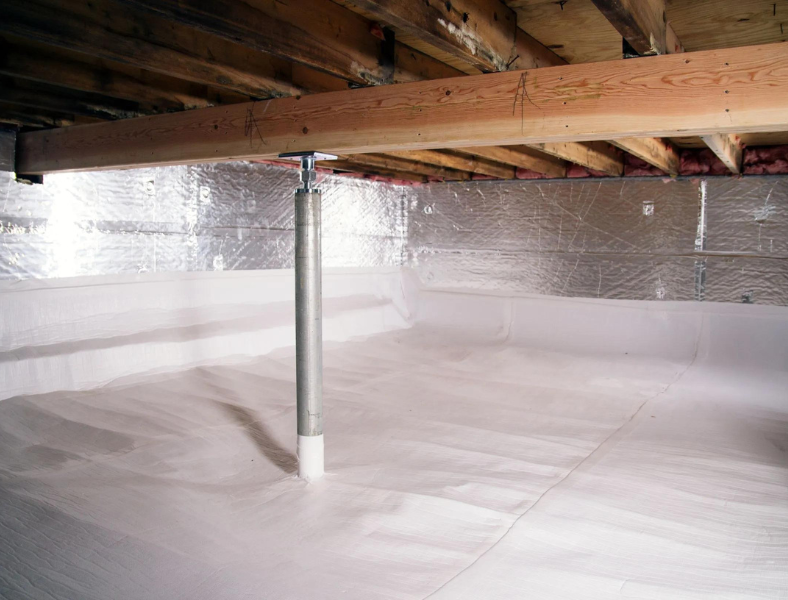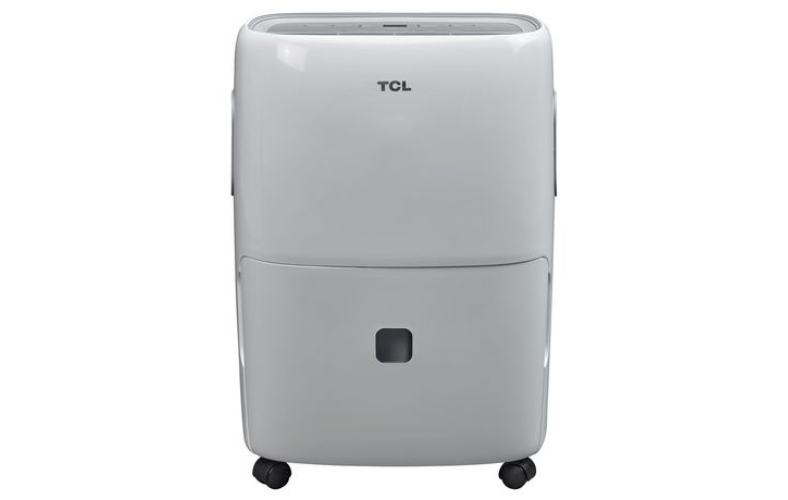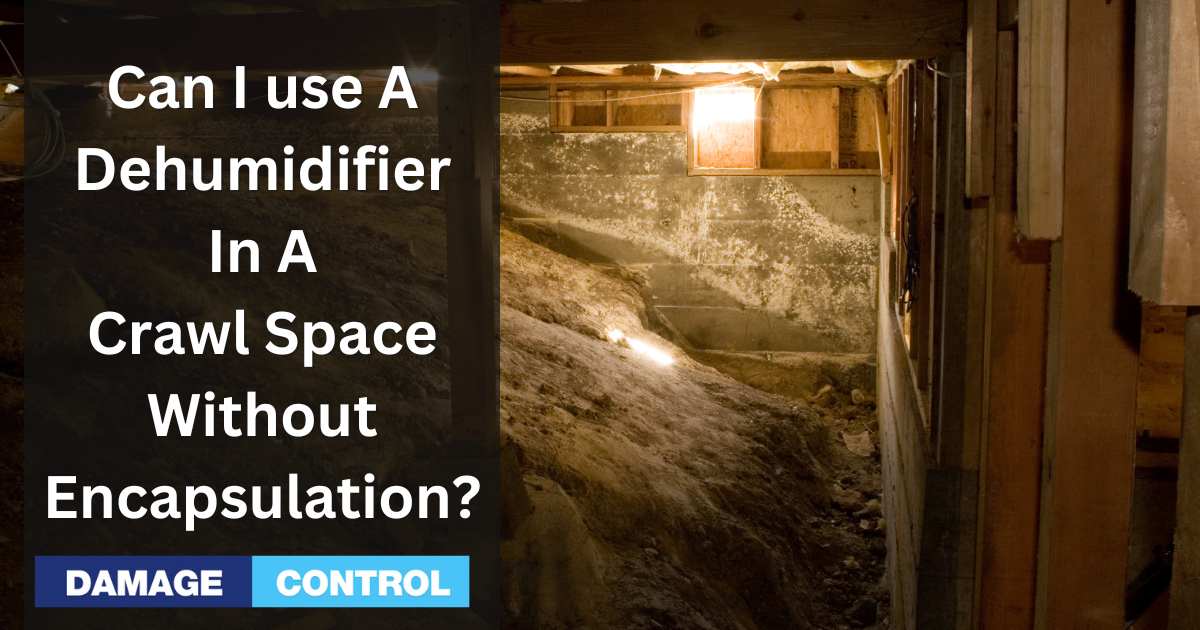Crawl spaces can get damp. And dampness leads to musty smells and mold. But what can you do about it?
Dehumidifiers are one solution. This article will help you decide if you can use a dehumidifier in your crawl space without encapsulation.
What Is Crawl Space Encapsulation?
Crawl space encapsulation is akin to providing your crawl space with a protective, moisture-resistant coat, much like donning a waterproof jacket to protect against rain.
This specialized process entails sealing the entirety of the crawl space with a robust barrier that wards off moisture, ensuring that humidity levels are controlled and the space remains dry.
The encapsulation journey often begins with the strategic placement of a vapor barrier, crafted from hard-wearing plastic sheeting, on the crawl space's floor and walls.
This potent barrier is meticulously sealed to various elements, including the foundation, supportive pillars, and adjacent walls. This results in an environment that's both airtight and impervious to water.
In certain scenarios, it might be beneficial to bolster the space with additional insulation or to introduce a dehumidifier to modulate humidity levels further.
But why consider crawl space encapsulation? The initiative primarily safeguards your dwelling from the adverse effects of moisture.
A well-encapsulated crawl space offers cleaner air by thwarting the growth of mold and mildew, which translates to a healthier living ambiance. Furthermore, it defends your home against potential structural harm like wood rot and rust.
Additionally, the sealing process enhances energy efficiency, minimizing drafts and conserving energy, potentially reducing your utility expenses. Not to be overlooked, a desiccated and sealed crawl space also becomes less appealing to unwelcome guests such as rodents and bugs.
In essence, crawl space encapsulation is a pivotal measure in preserving a healthful and energy-savvy home, ensuring the longevity and value of your property.
Can I Use A Dehumidifier Without Encapsulation?
Yes, you can use a dehumidifier in your crawl space without encapsulation, but it's essential to understand the pros, cons, and potential risks associated with this decision.
Pros
- Immediate humidity reduction: A dehumidifier will start removing excess moisture from the air as soon as it's turned on, providing quick relief from high humidity levels.
- Mold prevention: By reducing humidity, a dehumidifier can help prevent mold growth, which thrives in damp environments.
- Cost-effective: Installing a dehumidifier is usually less expensive than encapsulating the entire crawl space.
Cons
- Limited effectiveness: A dehumidifier may not be as effective in controlling humidity throughout the entire crawl space as an encapsulated space.
- Increased energy usage: Running a dehumidifier without encapsulation may require more energy, as it works harder to maintain the desired humidity levels.
- Ongoing maintenance: Dehumidifiers require regular maintenance, such as cleaning and filter replacement, to remain effective.
Risks
- Over-drying the air: Setting the dehumidifier to too low a humidity level may cause the air to dry, leading to issues like cracked wood or other materials.
- Incomplete humidity control: It is difficult for the dehumidifier to maintain optimal humidity levels without encapsulating the crawl space.
In summary, while using a dehumidifier without encapsulation is possible and can provide some benefits, it may not be as effective as a comprehensive encapsulation solution.
Consider the pros, cons, and risks before deciding if this approach suits your crawl space.
Factors to Consider Before Using A Dehumidifier
Before deciding to use a dehumidifier in your crawl space, it's essential to consider several factors to ensure you make an informed decision. Here are some key factors to keep in mind:
Crawl space size
 The size of your crawl space plays a significant role in determining the type and capacity of the dehumidifier you need. Larger crawl spaces may require more powerful units or multiple dehumidifiers to control humidity levels effectively.
The size of your crawl space plays a significant role in determining the type and capacity of the dehumidifier you need. Larger crawl spaces may require more powerful units or multiple dehumidifiers to control humidity levels effectively.
Make sure to measure your crawl space and choose a dehumidifier with a suitable capacity for your specific situation.
Humidity levels
Knowing the current humidity levels in your crawl space will help you understand the severity of the problem and whether a dehumidifier alone can manage it.
You can measure humidity using a hygrometer. If the levels are exceptionally high, you might need to consider additional measures, such as encapsulation, to control moisture effectively.
Dehumidifiers require a power source to operate. Before installing a dehumidifier in your crawl space, ensure a reliable and safe electrical connection is available. Sometimes, you might need an electrician to install an outlet or make other modifications to accommodate the dehumidifier.
Operating a dehumidifier involves ongoing expenses, such as electricity consumption and maintenance costs. Before investing in a dehumidifier, consider the potential impact on your utility bills and whether you will incur these additional costs.
Energy-efficient dehumidifier models can help minimize expenses, but weighing the long-term costs against the benefits of humidity control is essential.
By carefully considering these factors, you can decide whether using a dehumidifier in your crawl space is the right choice for your home.
Types of Dehumidifiers
 Image source: https://walmart.com
Image source: https://walmart.comVarious types of dehumidifiers are available, each with its advantages and disadvantages. Here's an overview of three common types:
Portable Dehumidifiers
Pros
- Easy to move: Portable dehumidifiers can be easily moved from one location to another, making them ideal for targeting specific areas with high humidity.
- Affordable: These units are generally less expensive than other types, making them a budget-friendly option.
- Simple to operate: Portable dehumidifiers are user-friendly and require minimal setup.
Cons
- Limited capacity: Portable units may be less effective in larger spaces or situations with extremely high humidity levels.
- Frequent emptying: Most portable dehumidifiers require manual emptying of the water reservoir, which can be time-consuming.
Whole-House Dehumidifiers
Pros
- Large coverage: Whole-house dehumidifiers can control humidity levels throughout the entire home, making them ideal for larger spaces.
- Low maintenance: These units typically drain directly into your plumbing system, eliminating the need for manual emptying.
- Better energy efficiency: Whole-house dehumidifiers are generally more energy-efficient than portable units, especially when managing humidity in larger spaces.
Cons
- Higher initial cost: Whole-house dehumidifiers are more expensive upfront than portable units.
- Professional installation: Installing a whole-house dehumidifier usually requires the assistance of a professional, which adds to the overall cost.
Desiccant Dehumidifiers
Pros
- Effective in low temperatures: Desiccant dehumidifiers use unique materials that absorb instead of a refrigeration system, making them more effective in colder environments, like unheated crawl spaces.
- Quiet operation: These units are generally quieter than other types of dehumidifiers, as they don't use compressors.
Cons
- Higher energy consumption: Desiccant dehumidifiers can consume more energy than other types, increasing utility costs.
- Regular maintenance: The desiccant material needs to be replaced periodically, adding to the ongoing maintenance costs.
When selecting a dehumidifier for your crawl space, consider the specific needs of your home, your budget, and the advantages and disadvantages of each type.
Benefits of Using A Dehumidifier In A Crawl Space
Utilizing a dehumidifier in a crawl space brings along a suite of compelling benefits that promote a healthier living environment and ensure the structural integrity of your home.
Firstly, by its very nature, a dehumidifier effectively reduces humidity levels in this confined space. Elevated humidity can often be the root of numerous issues in homes, and by curbing it, you're preemptively addressing potential problems.
One of the most prominent threats that high humidity poses is the proliferation of mold. Mold can quickly become a homeowner's nightmare, but a dehumidifier is a formidable barrier, preventing mold growth and its accompanying health risks.
Beyond mold prevention, the resultant effect is the enhancement of overall air quality in the home. With a dehumidifier actively working in the crawl space, the air circulating throughout your dwelling becomes fresher and healthier, free from dampness and potential mold spores.
Perhaps most crucially, a dehumidifier is instrumental in preserving your home's structure by maintaining an optimal humidity level.
Excessive moisture can weaken foundational components, leading to decay and compromise. A dehumidifier keeps the crawl space dry and ensures that your home stands strong and resilient for years.
Conclusion
Dehumidifiers can help control crawl space humidity, even without encapsulation. However, it's important to consider the risks and weigh your options. Keep your crawl space dry and healthy for a happy home.
FAQs
Can a dehumidifier be used in a crawl space without electricity?
No, dehumidifiers require electricity to function. Some models may have battery backup options, but a consistent power source is necessary.
Can using a dehumidifier replace the need for crawl space encapsulation?
No, dehumidifiers can't completely replace encapsulation. Encapsulation provides a more effective barrier against moisture, while dehumidifiers focus on reducing humidity.
Can I use a dehumidifier in a crawl space with mold?
Yes, you can use a dehumidifier in a crawl space with mold. However, addressing and remediating the mold problem is crucial before relying solely on a dehumidifier.
How often should I clean my dehumidifier?
Clean your dehumidifier regularly, as per the manufacturer's guidelines. Proper maintenance and consistent cleanings ensure efficient operation and prolong the unit's lifespan.
Can a dehumidifier help with radon levels in a crawl space?
No, dehumidifiers are not designed to address radon levels. Radon mitigation systems are specifically designed to reduce radon concentrations in your home.
Can a dehumidifier cause condensation on my windows?
It's unlikely for a dehumidifier to cause window condensation. If it does happen, adjusting the humidity settings on the unit should resolve the issue.
How much does it cost to run a dehumidifier in a crawl space?
The cost of running a dehumidifier depends on the model, power consumption, and usage. Energy-efficient models can help minimize costs.
Can a dehumidifier lower my heating bill?
A dehumidifier can lower your heating bill, as dry air requires less energy to heat than moist air. However, the impact on your bill may be minimal.

